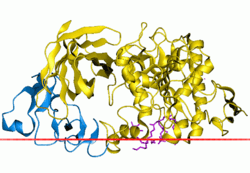Pancreatic enzymes (medication)
 Complex of lipase with colipase | |
| Clinical data | |
|---|---|
| Trade names | Creon, Pancreaze, Pancrex, others |
| AHFS/Drugs.com | Monograph |
| MedlinePlus | a604035 |
| Pregnancy category |
|
| Routes of administration | by mouth |
| ATC code | |
| Identifiers | |
| CAS Number | |
| DrugBank | |
| ChemSpider |
|
| UNII | |
| ECHA InfoCard |
100.053.309 |
Pancreatic enzymes also known as pancrelipase and pancreatin, are commercial mixtures of amylase, lipase, and protease.[1][2] They are used to treat malabsorption syndrome due to pancreatic problems.[1] These pancreatic problems may be due to cystic fibrosis, surgical removal of the pancreas, long term pancreatitis, or pancreatic cancer among others.[1][3] It is taken by mouth.[1]
Common side effects include vomiting, abdominal pain, constipation, and diarrhea.[1] Other side effects include perianal irritation and high blood uric acid.[3] The enzymes are from pigs.[3] Use is believed to be safe during pregnancy.[3] The components are digestive enzymes similar to those normally produced by the human pancreas.[4] They help the person digest fats, starches, and proteins.[3]
Pancreatic enzymes have been used as medications since at least the 1800s.[5] They are on the World Health Organization's List of Essential Medicines, the most effective and safe medicines needed in a health system.[6] In the United Kingdom a typical month's supply costs the NHS about 11.64 pounds.[3] In the United States a month of treatment typically costs 50 to 100 USD.[7]
Medical use
Pancrelipases are generally a first line approach in treatment of exocrine pancreatic insufficiency and other digestive disorders, accompanying cystic fibrosis, complicating surgical pancreatectomy, or resulting from chronic pancreatitis. The formulations are generally hard capsules filled with gastro-resistant granules. Pancrelipases and pancreatins are similar, except pancrelipases has an increased lipase component.
Pancreatin is a mixture of several digestive enzymes produced by the exocrine cells of the pancreas. It is composed of amylase, lipase and protease.[8] This mixture is used to treat conditions in which pancreatic secretions are deficient, such as surgical pancreatectomy, pancreatitis and cystic fibrosis.[8][9] It has been claimed to help with food allergies, celiac disease, autoimmune disease, cancer and weight loss. Pancreatin is sometimes called "pancreatic acid", although it is neither a single chemical substance nor an acid.
Pancreatin contains the pancreatic enzymes trypsin, amylase and lipase. A similar mixture of enzymes is sold as pancrelipase, which contains more active lipase enzyme than does pancreatin. The trypsin found in pancreatin works to hydrolyze proteins into oligopeptides; amylase hydrolyzes starches into oligosaccharides and the disaccharide maltose; and lipase hydrolyzes triglycerides into fatty acids and glycerols. Pancreatin is an effective enzyme supplement for replacing missing pancreatic enzymes, and aids in the digestion of foods in cases of pancreatic insufficiency.
Pancreatin reduces the absorption of iron from food in the duodenum during digestion [10]
Some contact lens-cleaning solutions contain porcine pancreatin extractives to assist in the intended protein-removal process.[11]
Society and culture
Brand names
Brand names include Creon,[12] Pancreaze, Pertzye, Sollpura (Liprotamase), Ultresa, and Zenpep.
Regulation
Longstanding pancreatic enzyme replacement products (PERPs)—some in use for a century or more—fell under a 2006 FDA requirement that pharmaceutical companies with porcine-derived PERP products submit an New Drug Application (NDA) for each; Creon (AbbVie Inc.), the first of the commercial PERP products approved after the FDA directive, reached market in 2009.[12]
The specific requirement and reasoning for the FDA directive was that manufacturers submit a Risk Evaluation and Mitigation Strategy (REMS) and Medication Guide to ensure patients are adequately informed regarding potential risks associated with administration of high doses of porcine-derived PERP products, especially with regard to "the theoretical risk of transmission of viral disease from pigs to patients", the risk of which (alongside other off-target effects) is reduced by patient adherence to label dosing instructions.[12]
References
- 1 2 3 4 5 "Pancrelipase". The American Society of Health-System Pharmacists. Archived from the original on 18 January 2017. Retrieved 8 January 2017.
- ↑ "Pancreatin". The American Society of Health-System Pharmacists. Archived from the original on 18 January 2017. Retrieved 8 January 2017.
- 1 2 3 4 5 6 British national formulary : BNF 69 (69 ed.). British Medical Association. 2015. pp. 82–83. ISBN 9780857111562.
- ↑ Stuhan, Mary Ann (2013). Understanding Pharmacology for Pharmacy Technicians. ASHP. p. 597. ISBN 9781585283606. Archived from the original on 2017-09-14.
- ↑ Bagchi, Debasis; Swaroop, Anand; Bagchi, Manashi (2015). Genomics, Proteomics and Metabolomics in Nutraceuticals and Functional Foods. John Wiley & Sons. p. 274. ISBN 9781118930465. Archived from the original on 2017-09-18.
- ↑ "WHO Model List of Essential Medicines (19th List)" (PDF). World Health Organization. April 2015. Archived (PDF) from the original on 13 December 2016. Retrieved 8 December 2016.
- ↑ Hamilton, Richart (2015). Tarascon Pocket Pharmacopoeia 2015 Deluxe Lab-Coat Edition. Jones & Bartlett Learning. p. 281. ISBN 9781284057560.
- 1 2 Whitehead, A.M. (1988). "Study to compare the enzyme activity, acid resistance and dissolution characteristics of currently available pancreatic enzyme preparations". Pharmaceutisch Weekblad Scienafic Edition. 10: 12–13.
- ↑ Löhr, Johannes-Matthias; Hummel, Frank; Pirilis, Konstantinos; Steinkamp, Gregor; Körner, Andreas; Henniges, Frederike (September 2009). "Properties of different pancreatin preparations used in pancreatic exocrine insufficiency". European Journal of Gastroenterology & Hepatology. 21 (9): 1024. doi:10.1097/MEG.0b013e328328f414. Archived from the original on 25 November 2015. Retrieved 25 November 2015.
- ↑ R. Stephton Smith (1965) 'Iron deficiency and iron overload' Arch. Dis. Child. 40, 343.
- ↑ Baines, M.; Cai, F. (1990). "Adsorption and removal of protein bound to hydrogel contact lenses". Optometry & Vision Science. 67 (11): 807–810.
- 1 2 3 U.S. Food and Drug Administration (May 7, 2009). "FDA Approves Pancreatic Enzyme Replacement Product for Marketing in United States: Creon designed to help those with cystic fibrosis, others with exocrine pancreatic insufficiency". News & Events, FDA News Release. Retrieved July 20, 2014.